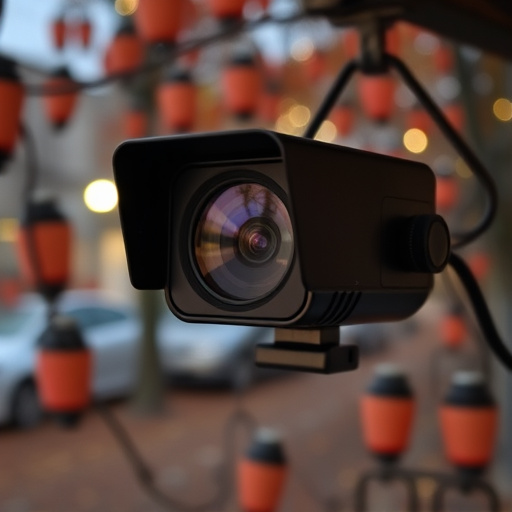Optical sensor technology has revolutionized industries with real-time object analysis. Disguising cameras within everyday items like streetlights and appliances offers enhanced privacy and security, sparking debate over potential privacy concerns. This advanced art form transforms ordinary objects into surveillance tools, with professionals using optical sensor detection to uncover hidden cameras. Today, tiny high-resolution cameras disguised as pens or flowers capture detailed footage discreetly, linked to analytics platforms for effective security protocols. However, this innovation raises ethical and legal questions regarding privacy versus public safety, requiring nuanced regulation.
Unveiling hidden surveillance through optical sensor detection is a critical skill in today’s tech-driven world. This article delves into the art and science of professional methods for identifying disguised cameras integrated into everyday objects. From understanding the fundamentals of optical sensor detection to advanced sweep techniques, we explore creative ways cameras are concealed and the ethical implications this raises.
Learn how experts uncover these hidden eyes, ensuring privacy and security in a world where discretion is no longer an option.
- Understanding Optical Sensor Detection and Its Applications
- Disguising Cameras: Creative Integration in Everyday Items
- Professional Methods for Uncovering Hidden Cameras
- Advanced Techniques for Sensor Sweep and Analysis
- Ethical Considerations and Legal Implications of Camera Disguise
Understanding Optical Sensor Detection and Its Applications
Optical sensor detection is a sophisticated technology that has revolutionized various industries, offering both innovative solutions and unique challenges. At its core, this method involves utilizing specialized sensors to capture and analyze light patterns, enabling the detection of objects or events in real-time. With advancements in hardware and software, optical sensors have found their way into countless applications, from healthcare and security to autonomous vehicles and robotics.
One intriguing aspect of this technology is its ability to disguise cameras within everyday objects, enhancing privacy and surveillance. By integrating optical sensors into seemingly innocuous items like streetlights, signs, or even household appliances, it becomes possible to monitor areas discreetly. This application has sparked both interest and debate, as it presents innovative security measures while raising concerns about potential privacy invasions.
Disguising Cameras: Creative Integration in Everyday Items
Disguising cameras in everyday objects has become an innovative and sophisticated method in optical sensor detection. Creative minds have taken this technique to new heights, integrating advanced imaging systems into seemingly innocuous items that we interact with regularly. From subtle hidden cameras disguised as buttons or light switches to miniature lenses concealed within common household goods, these stealthy devices offer a unique perspective on surveillance and documentation.
By merging technology with everyday objects, professionals can employ discreet methods for observation and data collection. This approach allows for unassuming monitoring in sensitive environments, providing valuable insights without raising suspicion. The art of disguising cameras showcases the versatility of modern sensor technologies, opening doors to enhanced security measures and innovative storytelling through unseen visual capture.
Professional Methods for Uncovering Hidden Cameras
Professional methods for uncovering hidden cameras involve a blend of advanced technology and meticulous observation. One sophisticated approach is to employ optical sensor detection sweeps, which use specialized equipment to identify digital image sensors that may be hidden within objects or spaces. These sensors, often found in covert cameras, reflect light differently than ordinary surfaces, creating unique signatures that can be detected.
In addition to technical tools, professionals also leverage their expertise and knowledge of disguising cameras in everyday objects. They scrutinize items like clocks, smoke detectors, and even plants for potential hidden components, as these devices can be cleverly modified to house covert recording equipment. This combination of cutting-edge technology and human ingenuity ensures that even the most sophisticatedly concealed cameras can be discovered and removed.
Advanced Techniques for Sensor Sweep and Analysis
In today’s world, advanced techniques for sensor sweep and analysis have emerged to enhance security measures. One innovative method involves disguising cameras in everyday objects. By integrating tiny, high-resolution cameras into seemingly innocuous items like pens, buttons, or even flowers, professionals can capture detailed footage without raising suspicion. This tactic leverages the element of surprise, making it a game-changer for discreet surveillance.
These hidden cameras are connected to advanced analytics platforms that employ machine learning algorithms to detect and track subjects. The data collected during sensor sweeps is meticulously analyzed to identify patterns, anomalies, and potential threats. This not only enables more effective security protocols but also reverberates in improved safety measures across various sectors, from corporate offices to public spaces.
Ethical Considerations and Legal Implications of Camera Disguise
The discreet placement of cameras in everyday objects, commonly known as disguising cameras, raises important ethical considerations and legal implications. As technology advances, these hidden surveillance devices become increasingly accessible, blurring the lines between privacy and security. One key concern is the potential invasion of personal privacy; individuals may not be aware that they are being recorded, leading to a loss of trust and security in public spaces and private homes.
Legally, the use of disguising cameras is regulated by privacy laws and regulations, which vary across jurisdictions. In many countries, there must be explicit consent for recording, with strict penalties for unauthorized surveillance. The ethical debate centers around balancing public safety and security needs against individual rights to privacy, particularly in places where camera disguise could facilitate crime prevention or catch offenders, but also risk overreach by authorities or malicious use by private individuals.
Optical sensor detection, particularly when disguised in everyday objects, presents a fascinating blend of technology and creativity. While it offers valuable applications for security and surveillance, the ethical implications cannot be overlooked. As professional methods continue to advance, it’s essential to maintain a balance between innovation and privacy. By understanding the capabilities and limitations of these techniques, we can ensure that the use of disguised cameras is both effective and responsible, respecting individual rights while leveraging technology’s potential.
